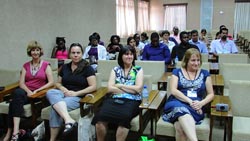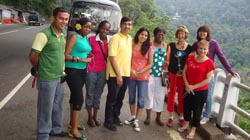The Crawford Fund Master Class was a two-week training course, held from the 1st -13th of December 2012 in the city of Kandy, Sri Lanka on all the skills and techniques of rhizobiology. Participants were from nine countries namely Zimbabwe, Zambia, Malawi, South Africa, Kenya, India, Thailand, Vietnam and the host Sri Lanka. The facilitators were from Murdoch University, Australia and the coordinators were from Australia and Sri Lanka.
The theme of the master class was "The isolation, identification and utilization of root nodule bacteria (rhizobia) in promoting sustainable agricultural productivity", divided into four modules:
- Isolation
- Characterization
- Authentication
- Inoculants technology
In the first module we learnt about the types of media (minimal and rich) and which type was appropriate for the different bacteria. We also learnt of the benefits of using some media like ½ LA media and Yeast Mannitol Agar and the different genera of rhizobia as well as phenotyping legumes and rhizobia. This module was interesting because we went into the mountains looking for different legumes using phenotypic features.
In the second module we learnt about the different types of characterization namely:
- Characterisation based on morphology of the colonies on the media plates i.e. the shape, size, colour of the colony and the number of days the colony takes to form;
- Biochemical process i.e. gram staining of gram negative and gram positive bacteria. Different bacteria absorb different dyes and produce different end products either acids or alkalines on different media;
- Characterization based on DNA (which was the most interesting because we do not use this method in Zimbabwe due to inadequate facilities). This is done by a process called PCR for Polymerase Chain Reaction. Here the DNA sequences with the desired genes is fragmented under a series of reactions under specific heat and pressure and the characteristics matched to a database. This was interesting because the magnitude of the impact of the results did not match with the micro-micro quantities of everything we used and also that unlike other techniques in microbiology where we worried about foreign substances on our skin as contaminants in PCR our skin was also a DNA contaminant and we had to wear gloves at all times and not touch our skin.
In the third module we learnt on methods of making sure what we had isolated and characterized was really rhizobia a process known as authentication. In this module we learnt to test how effective our isolates were and if they were rhizobia through a series of glasshouse tests and through trap hosting i.e. growing the desired host plant of desired rhizobia in a collected soil suspected to have rhizobia. We also did plating on different media and did colony counts of viable rhizobia using different media and calculation techniques and formulas for total viable colony counts. This was a bit strenuous but very interesting too.
Module four was about inoculant technology. This was about how you make broths for inoculants, how you inoculate these broths, setting up fermentation units, types of carriers for inoculants, how to introduce rhizobia to carrier packets and quality control of inoculants. This was also another interesting module because it reminded me of our achievement in southern Africa of having the biggest inoculants production plant in Marondera. It was also strenuous at times but very interesting. Also the facilitator was very patient because it took all the groups a lot of trials to achieve a broth that had minimal contamination.
In the second week of the training we had an excursion. We went to an elephant orphanage. Despite the elephant being one of the largest animals we learnt that it was also susceptible to abuse. There were some elephants that had been hurt by landmines and had part of their legs blown off. It was fun as we got the opportunity to feed some of the elephants and see some of the naughty elephants playing and chasing each other.
Kandy was interesting because it is mountainous and everywhere we went we would be winding and always had a lovely view. Also despite the course being intense, we had a lot of fun. We were from nine different countries, had nine different cultures, nine different languages and nine different beliefs but somehow all that didn’t even seem to exist because over the two weeks we became one big family. We ate together every evening, we went shopping and site seeing together, we literary did almost everything together.
 |
 |
 |
|
Some impressions of the Crawford Fund Master Class on Rhizobiology |
This was the most fulfilling training courses I have had. The closing ceremony was a very emotional one because we had become a close family, but it was time to say goodbye.
This training strengthened my willpower to make nitrogen fixation known to more people and benefit a lot more.
VIVA SRI LANKA!!!!!!!!!!!!!!!!!! AYUBOWAN May we live long so we might attend even much better and exciting training courses
Tatenda Kainga (MPhil student N2Africa)
